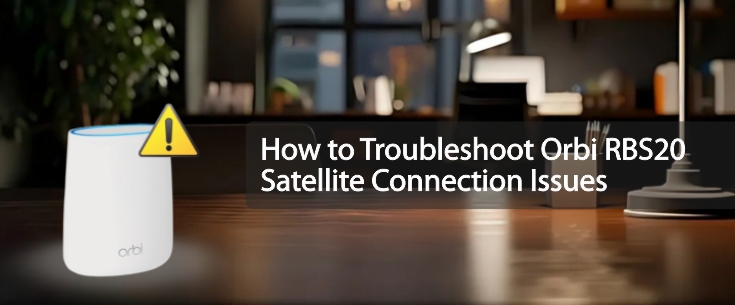
If your Orbi RBS20 satellite isn’t connecting like it should, don’t worry. You’re not alone, and it’s usually fixable without even a call support. Whether the satellite isn’t syncing, dropping off randomly, or giving you that annoying red light, This post will walk you through how to figure out what’s wrong and how to fix it. This guide is written for regular Orbi users.
Yeah, we know you’ve probably already rebooted it. But hear me out: power cycling both your Orbi router and the RBS20 satellite is still the best place to start. Unplug both. Wait for good 30 seconds. Plug the router back in first, give it about two minutes to fully boot up, then plug the satellite back in.
Give it a couple of minutes to reconnect. Sometimes, that’s all it takes.
While you’re at it, make sure the satellite isn’t shoved behind a metal filing cabinet or sitting on the floor. Physical placement matters. Ideally, the RBS20 should be placed halfway between your main router and the spot where your Wi-Fi gets weak. If it’s too far from the base, it’ll struggle. If it’s too close, it might not do much at all.
The LED on your RBS20 satellite actually tells you a lot—if you know what to look for.
If you’re stuck on red, you’re either out of range or something’s blocking the signal. Try moving the satellite a little closer to the router and see if the light changes.
If you haven’t already, download the Netgear Orbi app on your phone. It’s one of the more useful tools Netgear actually got right. Once you’re logged in, tap into the network map you’ll see which devices are connected and how strong the signal is to each satellite. From here, you can also:
Outdated firmware is sneaky. Your network might be running fine one day and suddenly go haywire after an ISP change or after you added new devices. Inside the app or via Orbi login through a browser (orbilogin.com), go to Advanced > Administration > Firmware Update.
Update both the router and the satellite if needed. Don’t skip this step. A lot of RBS20 satellite connection problems have been solved with a simple firmware refresh.
Sometimes the auto-sync fails. It happens. You can manually force a resync.
If it blinks and then goes red, try moving it closer and repeat the sync.
For more control, log in to your Orbi system through a browser. Just type http://orbilogin.com into any browser on a device that’s connected to the Orbi Wi-Fi. Enter your admin login (if you didn’t change it, it’s usually admin/password—though you should definitely change that).
Inside, you’ll see more detailed stats, including whether the RBS20 is showing as connected and how strong the backhaul signal is. This is also the place to change channels, reboot devices, or assign static IPs if needed.
This part often gets missed. The RBS20 uses both 2.4GHz and 5GHz bands, and both can be affected by interference.
Move the satellite away from microwaves, cordless phones, baby monitors, or thick concrete walls.
If you’ve got a ton of nearby networks, consider manually switching your Wi-Fi channel to a less crowded one via the Orbi admin interface.
If none of the above steps work, and the RBS20 still isn’t playing nice, it might be time for a factory reset.
Troubleshooting your Orbi RBS20 satellite connection should be taken seriously. More often than not, it’s usually because of long distance, interference, outdated firmware, or a weird sync glitch.
The Netgear Orbi app, combined with manual checks and a quick dive into the Orbi login page, give you all the tools you need to figure out what’s going on.
Disclaimer: We hereby disclaim ownership of any product and any association, affiliation or representation in any form, of any brand, product or service. All the information provided here has been drafted by a team of highly qualified technical experts and regularly undergo reviews and updates.